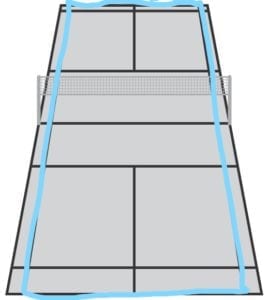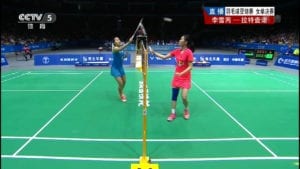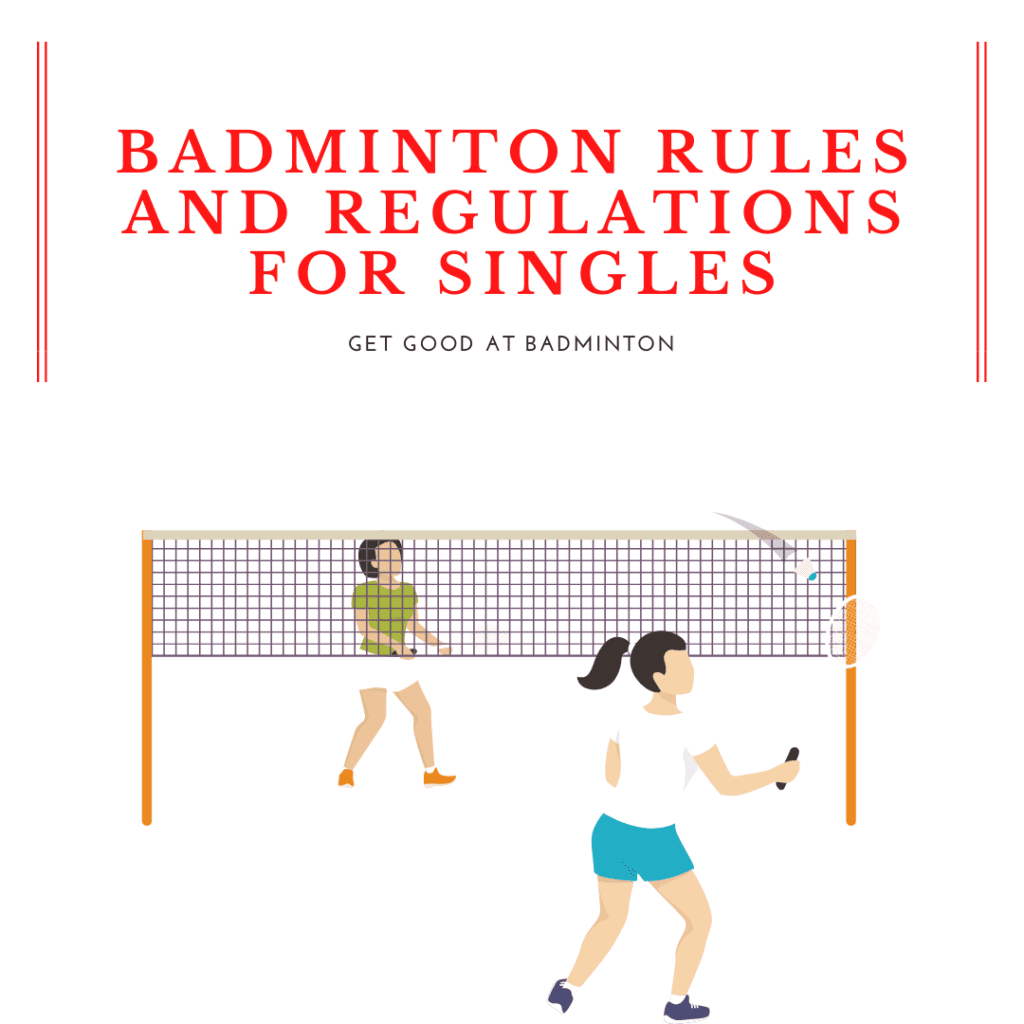In almost every game or sport in the world, there are rules. Rules and regulations are needed to maintain order in the games and badminton are no different. Thus, here I am making a post about badminton rules and regulations for singles players for those that want to get started playing.
Lines and Scoring
One of the most fundamental parts of badminton is scoring. There are two players in badminton singles; one on each side. To get points, the shuttle must either land in on your opponent’s side or land out on your side. Simple right? The whole point is to hit the shuttle within the court dimensions to somewhere your opponent can’t get it.
Usually, the first person to 21 points wins but if a deuce happens, one player must win by two points or until someone reaches 30 first. For example, if the score is 20-20, a player could not win 21-20, but they could win 22-20, 23-21, 24-22, all the way until 30-29. Matches would also usually be best of three.
Generally at 11 points and between games players get a short 30-second break where you can drink liquids, towel yourself down, and have your coach talk to you. You will also switch sides between games and at 11 points if you’re playing the third set.
Now, you need an understanding of what is out and what is in. A badminton court has two lines that run vertically and two lines that run horizontally. In singles, the court is long and narrow and thus we use the inner two vertical lines and the horizontal back line.

Anything that lands within the box or right on those lines is in, and anything outside those lines is out.
An interesting scoring system that was used about a decade ago required a player to have the service to score. For example, if I was playing against you and I was serving, I could score points on you, but you couldn’t score points on me. To score points on me, you would have to hit the shuttle down onto my side and reverse the service. During that time, players also played to 15.
Now you don’t have to worry about the old scoring system anymore. You can gain points no matter who’s serving!
If you play competitively, you should also note about challenging individual calls. Usually, the player who’s on the side that shuttle landed on gets to make the call if there are no umpire or line judges. There’s not much you could do if they call out a shot that you don’t agree with unless you are playing higher grade tournaments where you can challenge the call.
Unfortunate, but it is what it is.
Service and Starting A Game
Now that you understand how to win a badminton game and the scoring system, it’s time to talk about service and starting an actual game of badminton.
Before you start, you must decide who gets to serve. The official way to determine who gets to serve is by a coin flip. One person chooses heads, the other tails. Whoever wins the coin flip gets to decide who serves. This is the way they will do it in BWF tournaments and most significant matches.
However, there are other ways to start a match as well, and it’s often dependent on your tournament’s rules. One of the most common ways to start a game is by hitting the shuttle up and then giving the services to whoever the spinning shuttle points to.
Before you start the game, you should also know that in many cases both players can be granted a practice serve. If they don’t outright give you a chance to practice serve, make sure you ask if you’re allowed one should you need it. It all depends on the official tournament rules.
When serving, players should be behind the service line, which is the closest horizontal line to the net,
and on either side of the vertical line that runs through the middle. The side is determined by the score. Serve on the right side if your score is even and the left side if your score is odd. For example, if you are 2-0 against your opponent, you would serve on the right side while if you 1-0, you would serve on the left.

Hitting the shuttle must also be done in a certain way. The shuttle must land on or cross the service line of your opponent’s side, and your racket contact with the shuttle must be below 1.15 meters. Although this rule has been controversial because tall people have to bend down to serve while short people might even be able to serve above the waist, it does provide a more objective call compared to the previous rule, serve below the waist which had problems with judges being unable to identify the waist because of longer shirts and different body proportions.
Serving below the waist still works as the general guideline and the rule is still used in many lower level tournaments and gameplay. You can definitely continue using this rule unless you’re over six feet tall in which you may need to bend your legs a little.
If you’re in a match, after each game, the person who won will serve first.
Double Touch, Carries, and Other Faults
During the game, you may encounter several controversial shots that could be argued over. Many common ones are the shuttle hitting the ground and a player scooping it up to return it or if a player hits the shuttle multiple times while it’s still on his side.
Another common one is that if you touch the shuttle and it goes out, it is the opponent’s point. Sometimes players may decline that they touched it and if you don’t have an umpire making those calls, the two players must sort it out themselves.
Take note of some of these faults and watch out for them. They can be quite subtle.
Another thing to watch out for is how you move on the court between each rally. Tournaments generally don’t like it when you step off or walk around for too long. Trash talking and poor attitude can also be called out and punished. Just respect others, and you will be fine.
Playing Around The Net
One of the frequent calls argued over other than line calls in badminton is when a player hits the shuttle at the net. Here are some rules for net play.
- You cannot hit the shuttle while it’s on your opponent’s side.
- Your foot cannot be on the other person’s side when hitting the shuttle.
- You cannot hit the net with your racket or other parts of your body when playing the shot at the net.
These rules always create a setting for argument as the net game is so fast and hard to watch and make a call. It’s especially argued over when a player net kills, and the other player’s racket is up and blocks the net kill. They often have to play it in slow motion to figure out what was the best call.

Unfortunately, casual players don’t usually have an umpire sitting and watching the net from an unbiased perspective, and as such, the two players must make the call themselves.
One common misconception around badminton rules and regulations though is that if the shuttle hits the net, it’s out. This is not true as wherever the shuttle lands after hitting the net will be a point for one of the players.
Tournament Specifics

Badminton rules and regulations always vary little by little. Although what I said was pretty standard and equal to the officialBWF rules, each tournament might have their own little rules depending on certain factors.
Let’s take, for example, school badminton. In school, at least for me at the time, because of the restriction on time and space, matches were best of one and played to 15 with no deuces. Playing in school gyms also introduced a new variable of the ceiling which most called as out and even a rule of re-serving when players cannot agree with one another.
Also because of time and restricted space, some tournaments make it a rule that your coaches cannot talk to you at 11 points or even at all until you reach playoffs. Sometimes, things like how big the logos on your shirt are, what color your shirt and what shoes you wear can be rules as well.
Every tournament might be slightly different, but the general idea is not to complain but adapt. It’s part of the reason we tell you to play more badminton tournaments. You become more adaptable to different situations, and you won’t be relying on comfort rules and courts.
Conclusion
Did I miss anything? Comment down below on what you thought of this post! After seeing these rules, you should be okay to get yourself a game of badminton singles set up!
Additionally, click here to see rules and regulations for badminton doubles!
As always, good luck in your games and have a great day!


Thank you for sharing this very informative article! Keep on posting
Thank you!
What an amazing site. Full of great information about Badminton. I only played the sport as a pass time as a kid and never actually learned the rules but your site definitely provides all the necessary information. The site is very informative, well laid out and is visually appealing. Have you branched off into any other sports topics?
No, this site just focuses on badminton. Thank you for commenting!
I really appreciate your article Kevin covering Badminton Rules and Regulations For Singles, this was very informative to me as a novice badminton player and I am sure it will prove very helpful to others who are looking for information to play the game correctly but need that in common sense language like you provide.
You explain very well how the object of the game is to hit the shuttle in bounds on your opponent’s side where they can not get to it and they try to do the same. This is the same basic concept as tennis, volleyball, ping-pong and pickle ball but all the different games have varying rules so your article is key to helping those who are ignorant of the rules make sure they are following actual badminton guidelines.
Glad it helped!
Interesting site you have Kevin. Your passion and knowledge about Badminton really shines! I literally had no idea that Badminton was played at a professional or semi-professional level. I always thought of it as a leisurely game invented for backyard enjoyment or in a park. The rules seem pretty straightforward, similar to any court game with boundaries where opponents pass an object back and forth. I can see how points could be contested and argued over heatedly though…lo. Thanks for enlightening me more on Badminton.
James.
Thanks for commenting!
I loved this article! Why? Because I am a former physical education teacher and you simplified the rules. I know the rules are simple but you did an excellent job of explaining them. In addition, your pictures and the video were very well done. I’ve always loved the game of badminton. I’m tall, 6’6″, and I think that gives me a decisive advantage. I never played competitively but recreationally, which I took very seriously.
Thank you for the article. Well done.
Glad you enjoyed!
Your article on badminton rules and regulations is quite informative and as someone who has played badminton for years, I appreciate your clear and concise explanations of the rules and regulations for singles play. I couldn’t explain them better. You literally covered everything from serving and scoring to the different types of faults and how to avoid them and that was awesome. You also shared practical tips on strategy and technique, such as how to place your shots and anticipate your opponent’s movements and I found these tips to be particularly useful, as they helped me improve my own game. Thanks for the extensive guide here. Well appreciated.
Thank you for commenting!
I will only played badminton recreationally. Your blog post opened my eyes to so many rules, and things that I had never even known about. I honestly didn’t realize that there were so many tournaments that were available for people who like to play badminton. I know as a kid we used to sit the net up in the backyard and play for fun on a regular basis. Now I’m in my 50s so that was mini mini years ago and as you know things have changed for kids nowadays. sadly they’d rather sit in front of a computer screen instead of getting out and exercising with games like badminton and croquet. Thank you so much for this post. A greatly appreciated it.
Thank you for commenting!
Thank you very much for this valuable detailed post about Badminton Rules and Regulations For Singles. This is really an interesting post. I like to play badminton very much. I did a lot when I was a child. This post is really very important for those who are new to playing badminton. I will definitely share this post to continue posting like this.
Thank you for commenting!
This was definitely something I had fun doing growing up. I am not a professional by any means and always only played for fun. I was not aware of many of the detailed rules. This was very enlightening for me. I really enjoyed reading about badminton on a professional level. Its a refreshing new perspective. Thank you
Thank you for commenting!
Badminton is the game of my childhood! I adore it even now. I was surprised to find your website and this article. To tell you the truth, I had no idea about badminton tournaments and have read this article with a lot of interest. Thank you for the great work you have done!
Thank you for commenting!
It would seem the badminton court is smaller than a regulation tennis court/ The lines are pretty similar though. Are there regulations on cock construction?
How about foot wear? Is there proper shoes for wear at badminton tournaments? Can you wear the same athletic shoe for badminton as for instance, basketball or football?
This is good advice particularly for those considering tournament play. Thanks for the article.
Yes, badminton courts are much smaller than tennis courts. There are regulations on shuttlecock construction as well, though, they don’t really apply to how you play the game. For footwear, there are proper court shoes to wear, and many facilities require non-marking shoes to be worn. Although you can get away wearing basketball shoes, I would definitely recommend getting proper badminton court shoes.
Great article on badminton rules and regulations for singles! I especially appreciated the detailed explanations on the service and scoring rules. As a beginner player, I have struggled to understand these rules, so this article was very helpful. Thanks for sharing! Looking forward to implementing these rules in my next game!
Thank you for commenting!
I remember as a child when we visited our local sports Centre my Mom would always love to play badminton and though I used to watch, I was probably far to young to understand what rules applied to the game apart from hitting the shuttle from one player to another, but reading this breakdown of the rules has really given me a better understanding of how the game works. I wasn’t even aware that the court was different to a tennis court before reading this.
Thank you for commenting!
I just want to start off by asking is there a professional league for badminton? Because if there is, I want to join it. It seems like a pretty practical and easy sport. Pretty similar to tennis or volleyball I suspect. I used to watch these guys at my gym play it. Seem fun. Great article!
Yes, there is a professional league, but badminton is definitely a lot harder than it looks. Give it a try though!
Thank you for the detailed information on the various rules that govern badminton gameplay, including the scoring system, serving rules, and court boundaries. It also includes tips and strategies for players looking to improve their singles gameplay.
This is helpful resource for me who are new to badminton or looking to improve their understanding of the rules and regulations for singles play. It provides clear and concise information, as well as practical advice for players looking to enhance their skills and knowledge of the game.
Thanks for commenting!
Honestly I haven’t watched this sport very much and I didn’t know its rules and regulations so it was a good opportunity for me to know it better. It looks similar to tennis but obviously there are some major differences between the two. Overall a very good read. Thanks for sharing!
Thank you for commenting!
Nice post, it is useful for me. It is very informative. Thanks
Thanks for commenting!
sports are good for our fitness and health . thats great article thankew .
Thank you for commenting!
Hey, is it a rule that one player cannot play two single games?
Hi Hayley, one player cannot play two single games at the same time, but if the games are subsequent, there should be no problem. Hope that answers your question!
Great blog!Thats very informative and useful information here.I really appreciate it.Thanks for sharing this post.
You’re welcome!
Thats great article.Its useful information for us.Thanks for sharing this post.I really appreciate it.